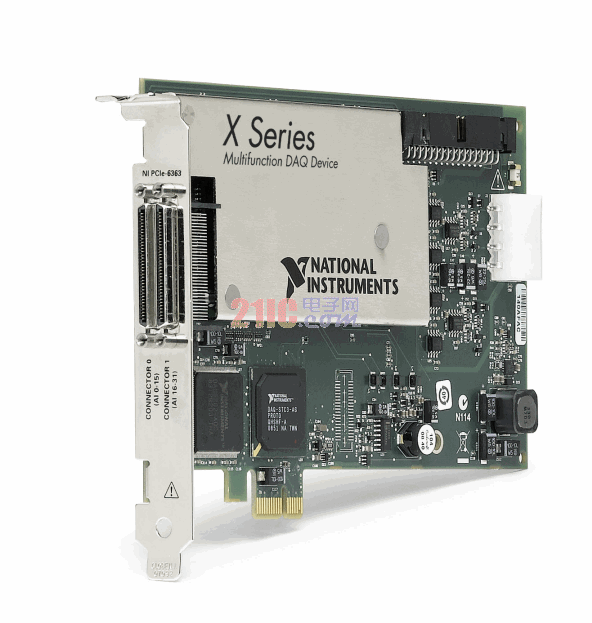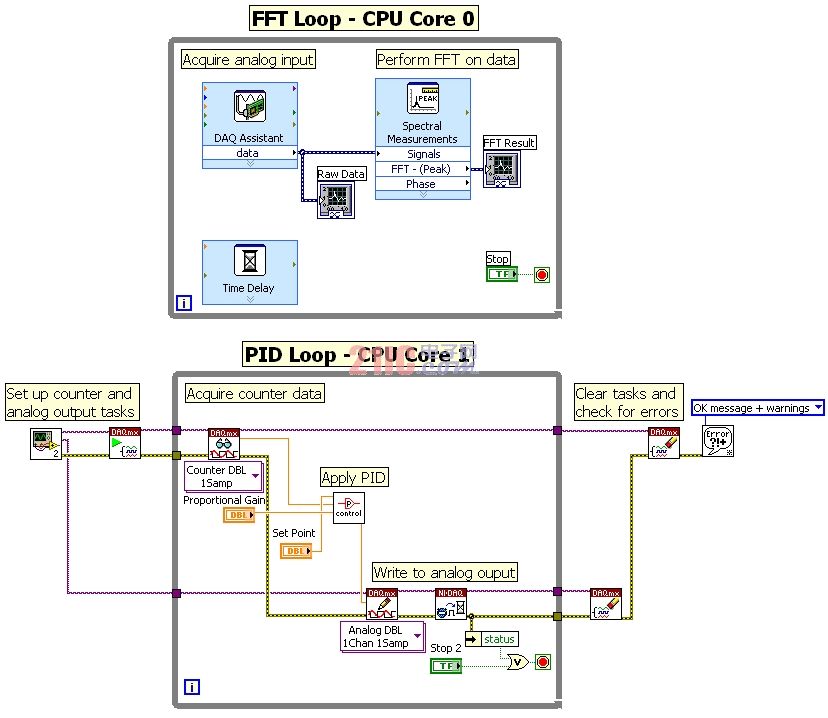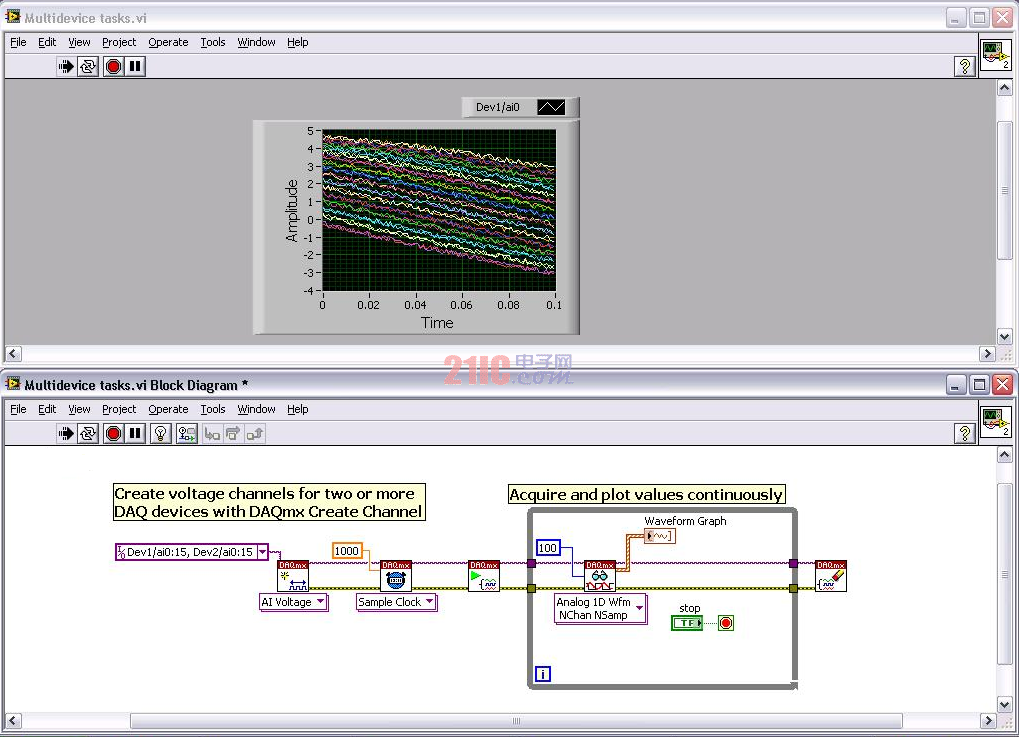The X-Series devices are the most advanced multi-function data acquisition (DAQ) devices designed by National Instruments to date. Introducing high-performance improvements with the easy-to-use NI-DAQmx driver software for Series X devices for the most demanding data acquisition applications. Combined with NI-STC3 timing and synchronization technology, high-processing PCI Express bus, and driver software for multi-core processors, the X-Series devices take PC-based multifunction I/O performance to new heights.
This article refers to the address: http://
NI-STC3 Timing and Synchronization Technology All versatile data acquisition hardware controls analog, digital, and counter I/O lines through on-board timing circuitry; timing ASIC technology has evolved over decades. After three years of development, the X-Series DAQ family incorporates new NI-STC3 technology with four improved counters, a 100 MHz timebase, and other I/O timing and triggering capabilities.
Four Improved Counters Previously, the original NI-STC ASICs offered on E-Series devices contained two 20 MHz counters with 24-bit resolution. Despite the versatility of those counters, many operations, such as pulse width modulation (PWM) or encoder measurements, require two counters to perform a single task. When creating a data acquisition system, counter resources are often exhausted earlier than expected. In 2004, the NI-STC2 ASIC was introduced into M Series devices and offered two 80 MHz counters with 32-bit resolution. In addition to speed and resolution, both counters offer more functionality because each can be used separately as a PWM output or encoder input channel. The new NI-STC3 technology extends the counter channel to provide four 100 MHz counters with 32-bit resolution. Not only does a single X-Series device have four counters, but operations that previously required two counters are now available through a single counter channel. For example, when you are controlling a stepper motor, you often need to generate a limited number of digital pulses; in the past, this required a counter to continuously generate pulses and another counter to apply these thresholds to the motor. This task can be accomplished with a single NI-STC3 counter, ie a single X Series device can control up to 4 stepper motors.
The onboard time base of the various data acquisition devices at 100 MHz is like driving the heart of all digital circuits. From sampling clocks to trigger lines, the time base is used as an onboard reference, which in turn generates the clock frequency and latches the digital edges. NI-STC3 technology uses a new 100 MHz timebase for a wide range of analog and digital timings, five times faster than previous NI DAQ devices. This means that the sampling frequency is 5 times more accurate than before, and the analog flip-flop can respond within 10 ns when the trigger condition is met.
Independent timing engine for analog and digital I/O
The advanced timing and triggering capabilities of data acquisition devices often rely on onboard counters and complex signal routing for specific hardware timing performance. NI-STC3 technology provides fully independent sample clocks and triggers for all types of I/O on multifunction devices. For example, retriggerable acquisition needs to wait for the trigger condition to be met, capture a limited number of samples, and then reassemble the trigger to prepare a new round of sampling. Using driver software functions to reassemble triggers may also miss a new round of triggering due to software latency; therefore, hardware timing may be required to achieve optimal performance. In the past, the counter was the only way to perform hardware timing re-triggering; the counter-generated retriggerable pulse sequence was internally routed and used as the analog input sample clock. Combined with the NI-STC3 technology offered by the new X-Series DAQ boards, analog channels eliminate the need for counters to perform retriggerable acquisitions, and triggers can be reassembled independently without software intervention. Another typical example of a new independent timing function is a new dedicated clock that is capable of acquiring or generating hardware-timed digital waveforms.
Module | Analog input | Highest AI sampling rate | Overall AI throughput rate ( all channels ) | Analog output | Digital I/O | DIO maximum clock frequency |
NI PCIe-6320 | 16 | 250 kS/s | 250 kS/s | 0 | twenty four | 1 MHz |
NI PCIe-6321 | 16 | 250 kS/s | 250 kS/s | 2 | twenty four | 1 MHz |
NI PCIe-6323 | 32 | 250 kS/s | 250 kS/s | 4 | 48 | 1 MHz |
NI PCIe-6341 | 16 | 500 kS/s | 500 kS/s | 2 | twenty four | 1 MHz |
NI PCIe-6343 | 32 | 500 kS/s | 500 kS/s | 4 | 48 | 1 MHz |
NI PCIe-6351 | 16 | 1.25 MS/s | 1 MS/s | 2 | twenty four | 10 MHz |
NI PCIe-6353 | 32 | 1.25 MS/s | 1 MS/s | 4 | 48 | 10 MHz |
NI PCIe-6361 | 16 | 2 MS/s | 1 MS/s | 2 | twenty four | 10 MHz |
NI PCIe-6363 | 32 | 2 MS/s | 1 MS/s | 4 | 48 | 10 MHz |
NI PXIe-6341 | 16 | 500 kS/s | 500 kS/s | 2 | twenty four | 1 MHz |
NI PXIe-6361 | 16 | 2 MS/s | 1 MS/s | 2 | twenty four | 10 MHz |
NI PXIe-6363 | 32 | 2 MS/s | 1 MS/s | 4 | 48 | 10 MHz |
NI PXIe-6356 | 8- way synchronization | 1.25 MS/s/ channel | 10 MS/s | 2 | twenty four | 10 MHz |
NI PXIe-6358 | 16- way synchronization | 1.25 MS/s/ channel | 20 MS/s | 4 | 48 | 10 MHz |
NI PXIe-6366 | 8- way synchronization | 2 MS/s/ channel | 16 MS/s | 2 | twenty four | 10 MHz |
NI PXIe-6368 | 16- way synchronization | 2 MS/s/ channel | 32 MS/s | 4 | 48 | 10 MHz |
Improved high throughput and low latency
The X-Series devices have several improvements for building high-throughput applications; in other words, these applications pass large amounts of data between devices and PC memory.
With the introduction of PCI Express and its integration into the PXI Express standard, the data bottleneck that once existed in the measurement system has gradually disappeared. Unlike PCI, which offers 132 MB/s of shared bandwidth, PCI Express provides a dedicated serial lane to each device with a theoretical bandwidth of 250 MB/s in all directions.
Some data acquisition devices convert PCI designs to PCI Express through a bridge, which results in the same bandwidth as PCI and adds latency. In contrast, the NI X Series offers its own x1 ("by 1") PCI Express and PXI Express interfaces with full PCI Express bandwidth. The X-Series for PCI Express can be used in PCI Express slots, from x1 to x16.

Figure 1. The X-Series for PCI Express can be used in a variety of PCI Express slots, from x1 to x16.
In addition, the X-Series includes eight DMA channels that can read and write data directly between the device and PC memory without CPU interaction or programming. These eight channels provide parallel data read and write for analog I/O, digital I/O, and all four counters/timers. The extended FIFO, which holds 512 samples, faces all four 32-bit counters and is now capable of performing buffered timer operations (such as event counting or generating PWM outputs) at speeds much higher than previous devices.
Like most internal buses, PCI Express's extremely low latency is ideal for closed loop control applications. The X-Series devices also extend the hardware-timed single-point performance of all subsystems in the device.
Parallel Processing on Multicore PCs To take full advantage of the parallel hardware subsystems on DAQ devices, you need high-performance drivers and applications.
As a driver for the X-Series, NI-DAQmx provides a simple, consistent API for all types of signal measurement and generation. NI-DAQmx is multithreaded, which means that user-developed applications can split the processing of measurement and generation tasks into separate threads. NI-DAQmx is tunable through multiple programming environments such as NI LabVIEW, NI LabWindowsTM/CVI, C/C++, Visual Basic 6, and .NET.
Combined with NI LabVIEW, users can easily connect to NI-DAQmx and optimize their data acquisition applications for use on multi-core computers. Users can create a While Loop for each measurement task; NI LabVIEW automatically divides your application into multiple threads. The operating system can then manage the optimal execution of these threads in one or more CPU cores. For example, a While loop is used for proportional integral derivative (PID) control and runs on one core, and a While loop processes Fast Fourier Transform (FFT) on another core.

Figure 2. Users can use the parallel While Loop in LabVIEW to process DAQ device I/O on different CPU cores.
The X Series requires NI-DAQmx 9.0 or higher. NI-DAQmx 9.0 adds 2 powerful features:
1. Fast and easy data logging. Users often need to record the collected data to disk for post processing or trend tracking. Users can now add a single "DAQmx Configuration Record" VI to the NI-DAQmx task with NI-DAQmx and then log the data into a TDM Stream (TDMS) measurement file. This method of writing TDMS files is also extremely fast: previous tests have shown that the write rate on disk may exceed 1 GB/s.
2. Multi-device tasks for the X-Series. For high channel count applications combined with the X Series, you can easily synchronize between multiple devices. For the PCI Express X Series, you need to interconnect them with Real Time System Integration (RTSI) cables. For the PXI Express X Series, modules can be synchronized to each other through the timing and trigger buses on the PXI Express backplane. NI-DAQmx 9.0 introduces multi-device tasks into the X-Series, which means users can create a set of measurement codes with 2 devices, and NI-DAQmx automatically manages the sharing of sample clocks.

Figure 3. NI-DAQmx driver software easily synchronizes two or more X-Series devices with multi-device tasks.
Conclusion The NI X Series devices, which improve timing and triggering, bus transfer, and data processing, represent the state-of-the-art DAQ devices designed by National Instruments. Utilizing state-of-the-art PC technology such as PCI Express and multicore processors, it is now able to create economical measurement and control systems that provide signal-to-software-level parallelism.
Home Using Solar Charger Controller use high-end shell which make of ABS engineering plastics. It has high strengh impact resistance. Heat-sink bottom desighned in line with aerodynamics is made of aviation aluminium materials. The wide cross-sectional are design connector makes connection easier.With our strict quality control, our home using Solar Charger Controller helps you build a sweet home.
Home Using Solar Charger Controller
Inverter Charger,Home Using Solar Charger Controller,Home Solar System Mppt Controller,Home Solar Systems Charge Controller
Guangzhou City Poojin Electronic Technology Co., Ltd. , http://www.inverter-belttt.com